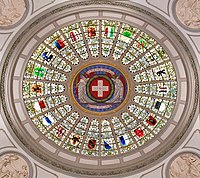Unterwalden
Unterwalden Unterwalden | |||||||||||||||||
|---|---|---|---|---|---|---|---|---|---|---|---|---|---|---|---|---|---|
| c. 1300–1798 1815–1999 | |||||||||||||||||
| Status | Canton of the Old Swiss Confederacy | ||||||||||||||||
| History | |||||||||||||||||
• Established | c. 1300 | ||||||||||||||||
| 1309 | |||||||||||||||||
| 1315 | |||||||||||||||||
• division of Obwalden and Nidwalden | before 1500 | ||||||||||||||||
• Disestablished modern canton | 1798 1815–1999 | ||||||||||||||||
| |||||||||||||||||
Unterwalden, translated from the Latin inter silvas.
The name Unterwalden is first recorded in 1304, as the translation of Latin inter silvas, which together with in intramontanis was the name for monastery possessions in the area. In 1291, Rudolf I of Germany purchased the estates at Stans, Alpnach and Giswil. From 1304, the local bailiffs used their own seal. In 1309, Henry VII confirmed the imperial immediacy of the territory of Unterwalden as part of the imperial bailiwick of Waldstätte (but not as a political entity in its own right). The
The division of Unterwalden into two separate territories, Obwalden and Nidwalden in the early period is less than clear. Their status as two independent Talschaften appears to develop over the course of the 14th and 15th centuries, while they retain a single vote in the Confederacy.
The
By the 1640s, these two designs were re-combined in a white-and-red key on a red-and-white field (per fess gules and argent, a key paleways with double
In
Unterwalden was restored in the Act of Mediation (1803) with a single constitution, but with two separate capitals, Sarnen and Stans, and two separate cantonal assemblies with equal sovereignty.[2]
Unterwalden was a canton of the
Gallery
-
Unterwalden depicted as one of the thirteen cantons in 1572. Its name is Latinized as Sylvania, and its date of foundation is given as 1315, the date of theFlag of Solothurn.
-
Standesscheibe of Unterwalden (16th century), showing the red-and-white design for Obwalden and the double-key design for Nidwalden.
-
1642 map of Underwalden (Matthäus Merian)
References
- ^ Unterwald), in the Historical Dictionary of Switzerland.
- ^ Fünfzehntes_Capitel_-_Verfassung_des_Kantons_Unterwalden
- ^ wikisource:Translation:Federal Treaty of 1815
- ^ Bundesverfassung der Schweizerischen Eidgenossenschaft. vom 12. September 1848.
- ^ "SR 101 (admin.ch)". Archived from the original on 2016-09-25. Retrieved 2018-11-15.
Further reading
- Emil Weber: Unterwalden in German, French and Italian in the online Historical Dictionary of Switzerland, 2013.
- Vnderwalden in M. Zeiller, Topographia Helvetiae, Rhaetiae et Valesiae (1642).
- Coolidge, William Augustus Brevoort (1911). . Encyclopædia Britannica. Vol. 27 (11th ed.). pp. 780–781.






